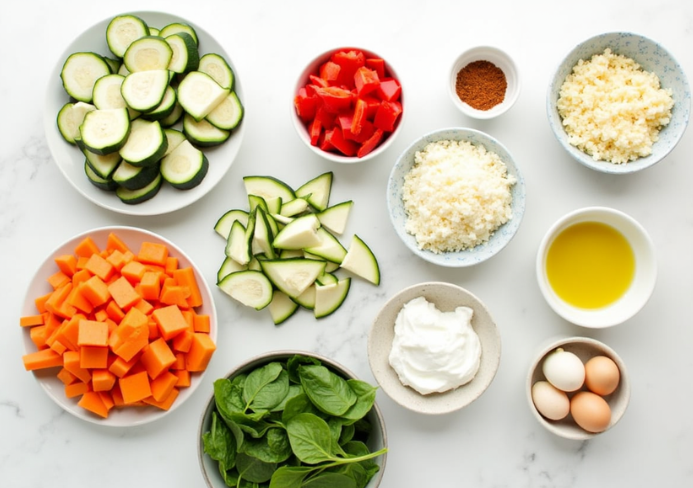A Hearty and Healthy Vegetable Casserole
Creating a hearty and healthy vegetable casserole is one of the most rewarding ways to enjoy a nutrient-rich, comforting, and flavorful dish that works for any season. Whether you’re cooking for the whole family, prepping meals for the week, or contributing to a potluck, this plant-based masterpiece can be customized endlessly to suit your taste and dietary needs.
Table of Contents
The Allure of a Vegetable Casserole
Vegetable casseroles combine the best of both worlds: they’re both satisfying and nourishing. With their layered structure, they hold textures and flavors beautifully while making use of common pantry items and fresh produce. Plus, casseroles are excellent for meal prep—just assemble and bake!
What makes this dish truly healthy is the diverse array of vegetables that provide essential vitamins, minerals, and fiber. For a breakdown of the nutritional power of vegetables, the Harvard T.H. Chan School of Public Health offers an in-depth look at how vegetables contribute to overall health.
Why It’s a Smart Addition to Your Weekly Menu
Packed with fiber, antioxidants, and plant-based goodness, a well-balanced vegetable casserole serves as a complete meal or a robust side. You can even freeze portions for later, making it a sustainable option for busy schedules. For smart techniques on freezing and reheating, check out The Kitchn’s guide to keep your meals fresh and flavorful.
Nutritional Benefits of Vegetable-Based Dishes
A vegetable casserole isn’t just satisfying—it’s a nutritional powerhouse:
- High in dietary fiber, which aids digestion
- Low in saturated fats and cholesterol-free
- A rich source of vitamins A, C, and K
- Provides complex carbohydrates for sustained energy
- Naturally low in calories yet deeply filling
Key Ingredients for a Hearty and Healthy Casserole
To create a casserole that’s both wholesome and delicious, choose a mix of flavors, colors, and textures.
Popular veggies to include:
- Zucchini
- Carrots
- Bell peppers
- Mushrooms
- Spinach or kale
- Cauliflower or broccoli
Healthy bases and binders:
- Low-fat cheese or plant-based alternatives
- Eggs or flaxseed mixtures (for vegan versions)
- Whole grains like quinoa or brown rice
- Greek yogurt, cashew cream, or tomato puree
Flavor boosters:
- Garlic and onions
- Fresh herbs (basil, thyme, parsley)
- Spices like smoked paprika, cumin, or curry powder
How to Balance Texture and Taste
A well-structured vegetable casserole depends on layering ingredients to build both taste and texture. Keep these principles in mind:
- Par-cook firm veggies like carrots and potatoes to ensure tenderness
- Add sauces or cheeses between layers to bind ingredients
- Use a crunchy topping (breadcrumbs or nuts) for contrast
- Avoid watery vegetables (like zucchini) unless pre-salted and drained
International Variations You Can Try
Explore global cuisines with these fun and healthy twists:
- Mediterranean-style with eggplant, olives, feta, and cherry tomatoes
- Tex-Mex version with black beans, corn, chili flakes, and cheddar
- Indian spiced with curry, cauliflower, and peas
- French-inspired using ratatouille-style layering of summer vegetables
Step-by-Step Recipe: Hearty & Healthy Vegetable Casserole
Ingredients:
- 1 cup chopped carrots
- 1 cup sliced zucchini
- 1 cup chopped bell peppers
- 1 cup mushrooms, sliced
- 2 cups baby spinach
- 1 medium onion, diced
- 2 cloves garlic, minced
- 1 cup quinoa, cooked
- 2 eggs or flax eggs (for vegan)
- ½ cup Greek yogurt or vegan alternative
- ½ cup shredded low-fat cheese (optional)
- 1 tsp olive oil
- Salt, pepper, herbs (thyme, oregano)

Instructions:
- Preheat oven to 375°F (190°C).
- Sauté onion, garlic, and firm vegetables in olive oil for 5-7 minutes.
- Stir in spinach until wilted.
- Combine cooked quinoa, sautéed vegetables, yogurt, eggs, herbs, and seasonings in a large bowl.
- Pour mixture into a lightly greased casserole dish.
- Top with shredded cheese or breadcrumbs if desired.
- Bake uncovered for 30–35 minutes until golden and set.
- Cool slightly before serving for better slicing.
Customization Tips for Every Diet
This dish is endlessly versatile. Adjust it to suit your dietary preferences:
- Gluten-free? Use quinoa or brown rice instead of pasta
- Vegan? Swap cheese with nutritional yeast or cashew cheese, and eggs with flax eggs
- High-protein? Add lentils, chickpeas, or tofu cubes
- Kid-friendly? Mix in some mashed potatoes or mild cheese for a creamier texture
Mistakes to Avoid for the Perfect Casserole
Even simple dishes like this have a few pitfalls. Here’s what to watch for:
- Skipping pre-cooking hard veggies (they won’t soften enough while baking)
- Overloading with water-heavy ingredients like fresh tomatoes or zucchini
- Not seasoning enough—salt and herbs are essential
- Serving immediately after baking—let it rest to firm up
FAQs: Your Top Vegetable Casserole Questions Answered
Q: What vegetables are best for casseroles?
A: Hearty vegetables like zucchini, carrots, cauliflower, peppers, and spinach work well. Aim for a mix of firm and leafy textures.
Q: Can you freeze vegetable casserole?
A: Absolutely! Wrap it tightly and freeze for up to 3 months. Reheat in the oven or microwave. Refer to this guide from The Kitchn for best practices.
Q: How do you keep casseroles from getting watery?
A: Drain watery vegetables before layering, and avoid raw zucchini or mushrooms unless pre-cooked.
Q: Are vegetable casseroles good for weight loss?
A: Yes—especially when made with whole grains, low-fat ingredients, and a variety of veggies. They’re filling, low in calories, and nutrient-dense.
Q: What should I serve with a vegetable casserole?
A: It works well with a light green salad, roasted legumes, or a whole grain roll.
Nutritional Breakdown & Final Thoughts
Each serving of this hearty vegetable casserole offers:
- Approximately 220–280 calories
- Around 10–12g of protein
- 6–8g of fiber
- Packed with vitamin A, C, and potassium
By using a base of fresh produce, healthy binders, and seasoning smartly, you’ll create a dish that’s not only delicious but nutritionally sound. For those following a vegetarian diet, the Cleveland Clinic’s guide is a great resource to explore your options and stay balanced.
Let this be your go-to dish when you want something comforting, customizable, and good for the body. The humble casserole just got a healthy upgrade—enjoy every bite!







